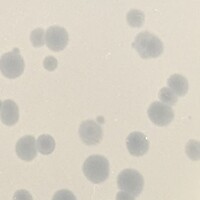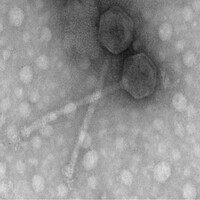Mycobacterium phage Hetestia
Know something about this phage that we don't? Modify its data.
| Detailed Information for Phage Hetestia | |
| Discovery Information | |
| Isolation Host | Mycobacterium smegmatis mc²155 |
| Found By | Ava Blackledge |
| Year Found | 2023 |
| Location Found | Bowling Green, KY United States |
| Finding Institution | Western Kentucky University |
| Program | Science Education Alliance-Phage Hunters Advancing Genomics and Evolutionary Science |
| From enriched soil sample? | No |
| Isolation Temperature | 30°C |
| GPS Coordinates | 36.952384 N, 86.47089 W Map |
| Discovery Notes | The sample was collected from a blue hole at Lost River Caves Park in Bowling Green, KY. The park had recently experienced rain, and the blue hole had more sediment stirred up in it as a result. The temperature upon collection was 82 degrees F, and it was moderately cloudy. |
| Naming Notes | Hetestia is separated into heterozygous (Hete-) for the mixed plaque morphology I often found on my serial dilution plates and Hestia (-stia), the Greek goddess of the hearth. |
| Sequencing Information | |
| Sequencing Complete? | No |
| Genome length (bp) | Unknown |
| Character of genome ends | Unknown |
| Fasta file available? | No |
| Characterization | |
| Cluster | Unclustered |
| Subcluster | -- |
| Lysogeny Notes | Hetestia was proven a temperate phage through an interesting phenotype experiment result and consequent lysogen experiment for confirmation. A spot plate incubated for 48 hours at 37 degrees C contained lysogens with the spots. This lysogen was picked to create a streak plate and incubated for several days at 37 degrees C. Then, several colonies were picked off the plate and inoculated in a sterile broth, which was also incubated at 37 degrees C for 24 hours before being placed in stasis in the fridge. This inoculate was used to create a bacterial lawn that was then spotted with dilutions of Hetestia. This experimental plate was incubated at 37 degrees C, along with a control of wild-type M. smeg that was also spotted with dilutions. The control tested positive, and spots were observed while the experimental plate tested negative and no spots were observed as expected. |
| Annotating Institution | Unknown or unassigned |
| Annotation Status | Not sequenced |
| Plaque Notes | Throughout the purifying process, Hetestia was observed to have a mixed morphology between small, clear plaques and larger, clear plaques. All with an organic circle shape. For this reason, five serial dilutions were performed to ensure the phage was purified before a high-titer lysate was created. |
| Morphotype | Siphoviridae |
| Has been Phamerated? | No |
| Publication Info | |
| Uploaded to GenBank? | No |
| GenBank Accession | None yet |
| Refseq Number | None yet |
| Archiving Info | |
| Archiving status | Not in Pitt Archives |
| SEA Lysate Titer | 1.65 * 10^10 |
| Available Files | |
| Plaque Picture | Download |
| Restriction Digest Picture | Download |
| EM Picture | Download |

